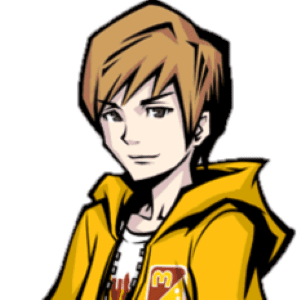Games that receive a ⭐ have a score of 95% or above. This is purely from a game design perspective and is not in any way related to our morality/parental warnings section.
The original Octopath Traveler from 2018 can best be described in my mind as the greatest game I have never beaten. In an era where many of the concepts and artistic flourishes of the 2d turn-based rpg are regarded as too outdated to appeal to modern audiences, even within Square Enix itself, along came this beautiful little semi-budget project which boldly executed on impeccably fun turn-based combat, beautiful visuals that became the signature style of its developers, some of the most amazing music in all of video games, and a delightful premise of following eight protagonists on their own personal adventures. But as much as I love Octopath Traveler, I’ve actually never beaten it on account of its wonky leveling curve and unambitious writing. Nonetheless I still regarded it as one of the best games on Nintendo Switch, and when the sequel’s demo dropped what started as an innocent enough preview of a game I might plan on playing in the future quickly turned into an absolute need to play more of it. But did this sudden new game in my review docket ultimately deserve its unannounced attention?
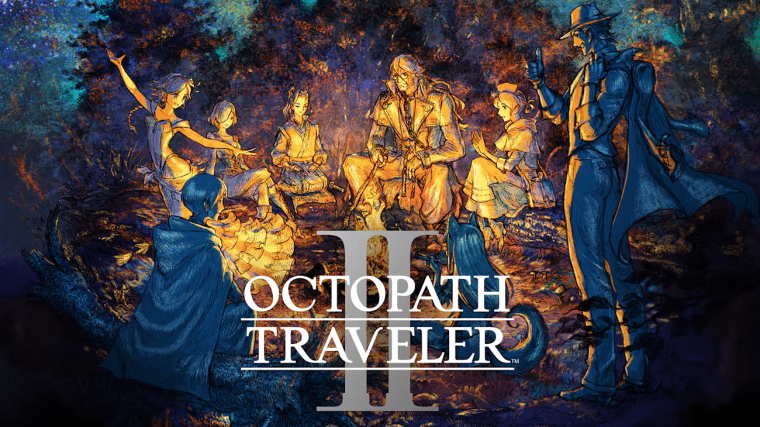
Co-Developed by Square Enix and Acquire, published by Square Enix, and released in February of 2023, Octopath Traveler II is an anthology role-playing game available on PC, PS4, PS5, and Nintendo Switch. Its premise involves eight heroes and heroines embarking on various personal journeys, and come together to overcome every last challenge their continent has to throw at them. Players interact with the game through turn-based battles, overworld exploration, and party customization. Please note that I played the Switch version for this review.
The story of Octopath Traveler II is… hmm, well I guess I can’t really describe this game’s prologue like I do most. As the name implies the story of the game follows eight different storylines, and you can start ANY of them as your first one when you boot up the game. These stories cover a huge breadth of genres, from exiled princes to prison breaks and revenge, to murder mysteries and to amnesia investigations, and many more. Broadly speaking, since these stories have to share the space of a single game they lack the kind of detail and depth that you would find in most role-playing games, but Octopath Traveler II nonetheless turned out to be an immensely cathartic narrative experience for me. This is because since each individual story’s runtime is only a few hours the narratives have to cut as much filler as possible, and the extra focus on scenes that matter really goes a long way to elevating the narratives. Even if the stories themselves aren’t the most unique on their own, the sheer earnestness of the writers’ delivery makes it impossible not to laugh, cry and cheer at all of them to some extent, and even then these stories sometimes go places you never would have expected and carve out their own identities.
If I had one minor complaint with the story, it would be that at times the writers try to distinguish themselves from the original game’s cast to a detrimental effect. Don’t get me wrong, there are ways in which they absolutely use contrast from Octopath Traveler I to open up new avenues of storytelling. For instance the original dancer Primrose felt like her class was more of a background detail to her personal goals, so they took the opportunity to make Agnea’s story all about her dancing career and it is excellent. However you also have cases like the cleric Temenos, who the storytellers clearly wanted to be a 180 from Ophilia since she was the most cleric-y cleric to ever cleric. While they succeeded in making him an entertaining and even compelling character to follow, there are times where you look at the things he says and feel less like that’s something Temenos would say and more like that’s something the writers made him say for the sake of contrast. Ok well, all writers technically contrive everything their characters say and do, but this is a case where the hand of the writer is obvious and breaks my suspension of disbelief. Still, this problem is hardly an issue that weighs the game down too much, and it’s also not really a big enough deal to diminish how satisfying Octopath Traveler II’s narratives really are. And heck, they even addressed the original game’s biggest criticism of the character stories feeling too disconnected by adding in crossover chapters for the characters, and eventually tying them all together in a grand finale.
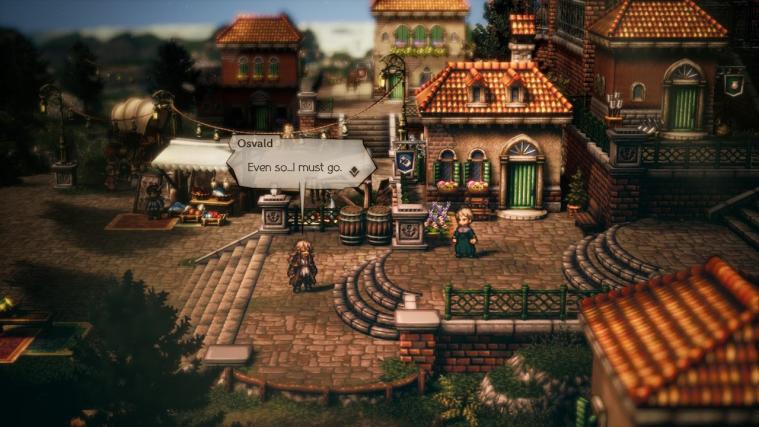
Anyways before we move on from the story, let me give you a rapid fire overview of each character so you know what to expect going in and maybe help you decide which protagonist to start with. Ochette the hunter’s story is probably the weakest on account of its overtly McGuffin-based plot structure and its incessant need to remind the audience ‘humans bad, nature good’, but she does have enough goofiness going on to be a decently fun time (disclaimer: I am thoroughly antagonistic against catgirls). Castti the apothecary has an excellent story which subverts every terrible memory loss trope by making her an active character who doesn’t let her condition diminish her desire to help others. Throné the thief’s story gave me MAXIMUM EMOTIONAL DAMAGE (this is the best one, I promise. Its boss fights have amazing storytelling through gameplay). Osvald the scholar’s story follows an admittedly edgy revenge quest at first, but as the story progresses and more information is given to the player it really came to grow beyond its initial premise in a way I could appreciate. Partitio the merchant’s tale is a neat story that tackles themes of using commerce in a way that helps people, without condemning the practice altogether like many stories of our time often do. Agnea the dancer’s path is a really bright and upbeat journey to stardom that puts a smile on my face each time I think about it. Temenos the cleric’s story is essentially a medieval buddy-cop murder mystery with excellent dialogue and a protagonist who is fun to read the true feelings of, even despite my issues with his characterization. And finally, Hikari the warrior’s tale is anime camp right down to its samurai aesthetics, but it is still well told overall.
The bedrock of Octopath Traveler II’s gameplay is its combat system, which stays true to its predecessor while expanding upon it in small but meaningful ways. Each round of combat sees the heroes and enemies placed on a timeline based on their speed stat, and each character takes their turn in order. The trick with this system is that every enemy has a selection of weaknesses to certain damage types, and a number of shield points that decrease when hit by their weaknesses. Reducing the shield to zero will put them in a broken state which removes all of their actions from the current and next round, which also makes them more vulnerable to damage. The party also has access to a number of boost points which regenerate at a rate of one per turn, and can be spent to hit the enemy multiple times with a basic attack or intensify the effectiveness of a skill. These two systems create the basic structure of combat, but there is endless depth in figuring out how best to apply these systems. Sometimes you need to spend boost points to quickly break an enemy before it unleashes a powerful attack, and other times you’ll want to break enemies without your boost points in order to spend them on dealing the maximum possible damage during the break period. The main new feature in this installment is a gauge called Latent Power, which gives each character a unique and powerful effect to further open up options, and the effects range from breaking shields with any type of damage, to extending the reach of buffs to the whole party, to instantly filling the character’s boost gauge. This addition emphasizes each character’s unique skills and keeps each traveler relevant in a particular way even after sub-jobs are unlocked later into the game, which is a whole other layer of strategy in and of itself!
All these systems provide the player with a robust set of tools to overcome the various challenges in the game, and you are going to need those tools because Octopath Traveler II does not pull punches. The game does a good job to teaching you the basics of how each character works and skill descriptions are simple enough, but the boss enemies which serve as the game’s main roadblocks have very tricky mechanics which require a lot of experimentation and observation in order to find what actually neutralizes them long enough for you to win. By the level 45 section of the game you will need to learn how to combine each character’s best skills or do some serious grinding in order to come out on top. But that’s exactly the thing: the game is hard but it gives you every opportunity to find and exploit its weaknesses. To be perfectly up front, at the time of writing this I haven’t even beaten the true final boss and have watched the cutscenes following it online just to finally get this review done, but I don’t blame Octopath for being hard so much as I blame myself for not playing more carefully and exploring every avenue, and I look forward to finally discovering the answer. Of course it is worth mentioning that a lot of the time between bosses will be spent fighting enemies just to level up enough to stand a chance, however the natural encounter rate is high enough that you’ll be gaining plenty of EXP assuming you don’t run from fights much, plus you can definitely subvert being a lower level so long as you have at least one or two high level characters to play around.
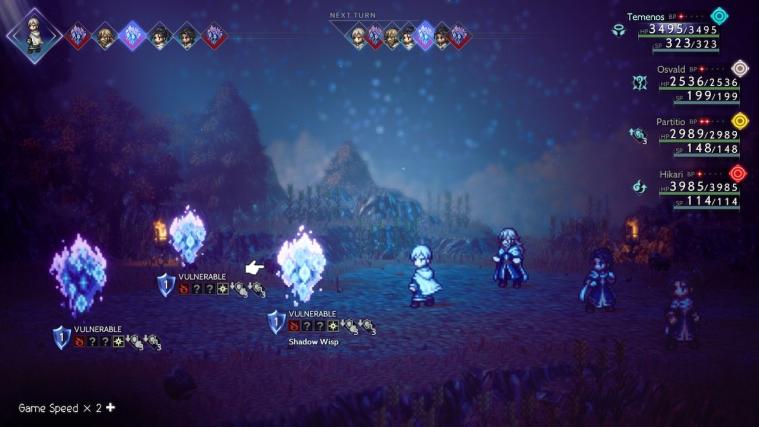
The exploration side of the game is quite simple on the surface, with basic side quests to make money and get items, and overworld maps and dungeons with relatively easy treasure chests to find. Where Octopath Traveler II makes this more interesting is in the way you interact with the npcs through Path Actions. Path Actions were another staple feature of the original title where each character had a special ability they could use when talking to townsfolk. They could be categorized into the types of item acquisition, travel invitation, information gathering, and knockouts. Within each category there was one action which usually had a level requirement before it could be used, and one where you could use it at any time but failure could damage the party’s reputation in the town. This system underpinned the near entirety of Octopath Traveler I’s side quest system (in fact it kind of still does), as they were almost all exploration challenges of figuring which NPC you needed to find what actions you needed to take on them. This however created a tension where you perhaps wanted to play with a certain party loadout, but it would be inconvenient to not have one of each of the four action types so party building ultimately came down to having these actions available, unless of course you were willing to bear the annoyance of swapping characters at the tavern whenever they became relevant to a quest.
Octopath Traveler II fixes this issue entirely by adding one simple mechanic to exploration: time. With the press of a button the player can now shift the entire game from day to night, which can adjust the encounter rate when traveling, activate certain passive abilities which are amazing for speeding up long grinding sessions, and change the positions of most NPCs in the world. But most importantly, in addition to all of the classic Path Actions being available during the day, a whole other set of new Path Actions are accessible during the night. With each character consequently now interacting with two of the four categories, the odds of you selecting a team which fails to cover everything is really low. For instance, if you like me started with Temenos, who has the ability to Guide people by day and Coerce them by night, you could have every base covered just by adding Throné and her Steal and Ambush skills, and even if you didn’t there’s still a very low chance of comprising a team totally devoid of item acquisitions or knockouts. This of course isn’t to say swapping characters for quests isn’t important as some NPCs might only come out during the day or the night, thus limiting who you can use to complete objectives. However this is relatively rare and feels more like a welcome challenge when compared to the looming threat of the previous game’s system. And considering Octopath II still has its predecessor’s smart design of allowing you to beat some quests in multiple ways if you search thoroughly enough, even this can be avoided in some scenarios. On the whole this game’s mechanical systems are objective improvements in pretty much every way, to the point that you look back at the previous game and almost get a little sick just thinking about it. Not that the old game is bad, but this one is just objectively better.
On the presentation side of things, Octopath Traveler II’s visuals can only be described as an unfettered triumph. Triangle Strategy gave us hints of how the art team had been iterating on the HD-2D art style, but nothing could have prepared me for the sheer beauty in store here. The sprite work is more expressive and complex than anything we’ve seen so far, environments return to the original’s forced perspectives which bring out the best in every location, and they even incorporated more dynamic camera work to communicate especially dramatic moments in both cutscenes and combat. You will know they were bringing their A-game when you unleash a full-boost skill attack and the camera reframes the whole attack with a wide swing. The particle effects are also spectacular and really sell the power and vibe of both the simplest strikes and the grandest spells. But Square Enix took themselves so much further with the lighting in this game, it’s not even funny. The entire game is not only lavishly, photorealistically lit to perfection in every nook and cranny, but they did it twice for both day and night. It sounds ridiculous to claim that a game with sixteen-bit style spritework characters could be one of the most immersive games of the decade so far, but against such masterful craftsmanship I could not help but believe in how alive the continent of Solistia feels. Absolutely incredible stuff.
And then we have the music. The music. The music. The music. The music. THE. MUSIC.
Ok, so the original Octopath Traveler’s score was and still is remarkably good, so much so that it is one of two video game soundtracks I have downloaded on my phone in its entirety (the other being Supergiant Games’ Pyre). All of the same fundamental design is here, with the average track being maybe two minutes at most before looping, but said tracks are so evocative and grand that it’s more like the composer knew we’d want to listen to these melodies over and over and just made hitting replay less intrusive. Octopath Traveler II’s score maintains all of this, and yet the music it provides is just so rich and detailed I can hardly believe one game can have this many good themes in it. Every melody is gorgeous, and surrounding every melody are amazing harmonies, chords, and percussion that makes listening more closely a transcendental experience. And when you change from day to night, almost every area has a second version accompanied by lighter but no less soulful instrumentation, and even sometimes these wonderful, airy nonsense vocals. The game makes no small effort to highlight its heavenly soundtrack at every opportunity, between the unlockable gramophones for which you can buy songs from various shops to listen to, Agnea’s story focusing so heavily on the performing arts, and more.
But perhaps my favorite part of the soundtrack, and probably a lot of other people’s favorite part as well, is its use of the travelers’ leitmotifs. Now leitmotifs are a video game staple which helps composers cover a broad range of subjects and contexts without having to create new melodies from scratch constantly, but there’s something about their implementation in Octopath Traveler II that’s difficult to put into simple terms and yet makes them so profoundly lovable. Perhaps the simplest way to explain it is to show how it took existing Octopath conventions and expanded upon them in stellar ways by emphasizing leitmotifs further. Let’s take for example the leitmotif of Hikari: its base rendition can be found in the song aptly titled Hikari, the Warrior. This establishes the tone of his entire journey, as well as playing up the eastern wind and string instrumentation that is common in other music from his homeland of Hinoeuma. As you play through his story and come to face his bosses, the boss fight themes are built up to with the song In Pursuit of Kingship, which was an iconic feature of Octopath Traveler I’s soundtrack but is further perfected since II’s build up themes use the actual leitmotifs as opposed to mere instrumental nods to the characters’ themes. And finally during the climactic final battle when the boss moves into its final phase, the final boss theme For the Dawn becomes intertwined with Hikari’s theme, creating the euphoric track titled The Journey for Kingship Ends. And in case the delightfully candor title of the game didn’t tip you off yet, this is done eight times over. Well, Agnea’s final boss track is a little different but… I don’t wanna give away everything do I?
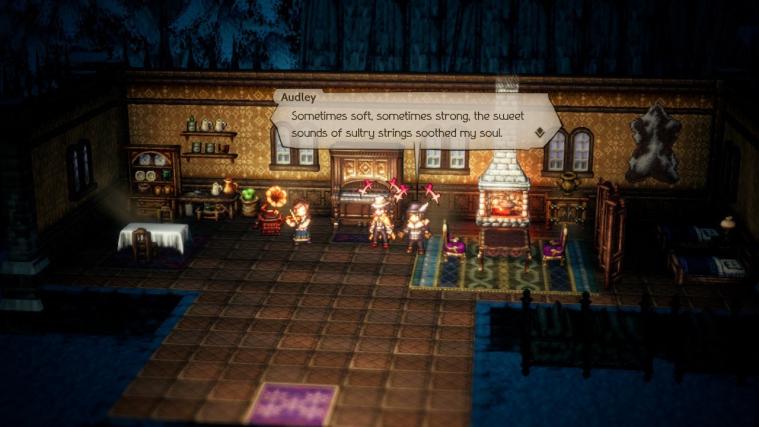
In conclusion, the fact that this game’s soundtrack is currently only available on the Japanese iTunes store is an international affront, and I WILL be bringing my case before the U.N. in 20XX requesting sanctions unless they release the soundtrack internationally before then.
Lastly, in regards to what we can take away from this game as Catholics, it is difficult to land on just one message in this regard because the story goes in so many different directions and talks about so many different things. What I think stuck out to me the most in Octopath Traveler II was just how much I found some of the game’s quietest moments to be the most impactful. As you progress through the main story, you’ll see these bonus conversations called Travel Banters be prompted by the system, and it features short scenes between the characters reacting and relating to whatever events are going on. And don’t worry, you can read all of them later by going into the story rewatch menu. And some of the best interactions in the whole game can be found here. It’s things like watching Partitio bear witness to a grave injustice and coming up with a way to right it wholly out of his own pocket, watching Hikari’s idealism enrich his companions in unexpected ways, and watching Osvald’s carefully guarded heart break through his cold exterior.
In a similar way, I think we can be reminded that the most beautiful and intimate glimpses of our true selves, of life’s meaning, and indeed of God, come to us not in our most visible experiences, but in those moments away from the highlights of our journey. It is as with Elijah in the cave, where despite the winds, earthquakes, and fires he recognized the Lord by a light, quiet sound (1 Kings 19:9-13). The interior silence and wisdom to look in the quiet places in the world for our God and our purpose seems to come less easily than ever in our day, and yet we must strive to find that moment to stop and pray, or to meet our brothers’ needs when we catch a glimpse of them. The path we travel to Heaven is long and has many winding passes, but in the same way that engaging with these smaller scenes in an RPG helps us to better find proper emotional connection with the characters in the story, we must also forget not to seek the quiet sights on the road home in order for that journey to bear its ripest fruit. Sure not everything we see and do in the background of our lives will ultimately be world-shaking, but maybe we need not shake the world so long as we brighten the place we happen to be sent to. Those small prayers certainly have a greater impact than we could ever imagine.
So to conclude, Octopath Traveler II is one of the most incredibly well-crafted video games I have ever played. The criminally undeserved bad reputation of turn-based RPG combat in the modern era and its high difficulty will probably doom the title to relative obscurity. However, now that this article has brought it to your attention and you know of its emotional storytelling, tightly designed gameplay, and unmatched presentation and music, I’m confident that if anything here sounded remotely interesting then you will fall in love. It is crazy to me how quickly this game went from innocuous sequel to all-time great in my mind, but I’m happy to have encountered a surprise of this caliber in my lifetime. Easily my highest recommendation to date.
Scoring: 100%
Gameplay: 5/5
Story: 5/5
Art and Graphics: 5/5
Music: 5/5
Replayability: 5/5
Morality/Parental Warnings
Octopath Traveler II takes place in a fantasy setting with various supernatural elements. The pantheon of gods that created it are, aside from being a patheon in and of itself being illogical, depicted as surprisingly weak insofar as they have to exhaust themselves to the point of eternal slumber just to seal away the devil figure, who seems to suffer no similarly permanent consequences. While the presence of The Sacred Flame speaks to an enduring legacy of theirs, it’s hard not to notice how shaky the continued existence of the spiritual good is in the setting when compared to the relatively more self-sufficient spiritual evil forces. The Order of the Sacred Flame borrows Catholic aesthetics and is generally a force for good, to the point where the corruption depicted in the game is largely the fault of explicit heretics and bad actors. The true villains of the game are centered around nihilistic motivations, but at least they are never depicted as anything other than totally wrong in the end. Magic in this setting is largely a scholarly pursuit concerned with metaphysical formulae, however dark forms of magic involving sacrifices and such do also appear in the story. Combat involves the usual variety of melee weapons, bows, and spells, but blood is mostly absent outside of a few bosses where it is present to communicate the flavor of certain mechanics. Enemy designs range from goofy little critters to some rather frightening abominations.
The pixel based art direction limits the amount that can be done to include immodest character designs, however some bosses like Agnea’s final boss feature considerably more titillating appearances, and some of the character artwork such as Throné’s also draw attention to their sexy design elements. In general the intentionally limited graphics actually allow the writers to explore much darker themes than most T-rated games, spanning subjects like physical and mental abuse, slavery, genocide, murder, treason, possesion, prostitution, human experimentation, and even abortion (thankfully that last one is treated as a stark negative, and even explores perspectives often ignored in mainstream discourse). Ochette’s story features environmentalist themes which are heavily un-nuanced and anti-human at times, but at least its final conclusion turns out to be nothing offensive. Throné’s story is responsible for much of the game’s darker content. Osvald is motivated by revenge at the beginning of his tale, but ultimately it isn’t glorified. Temenos is surprisingly historically accurate in his duty as an Inquisitor, emphasizing the self-policing nature of the position quite explicitly, however his healthy skepticism can often devolve into outright cynicism. Foul language is present, although I can’t remember anyone swearing just to add more swears to the script. There is a side quest with reference to homosexuality.
